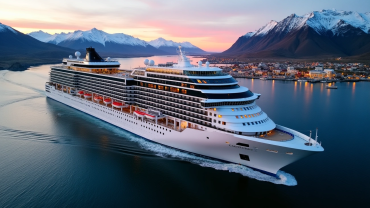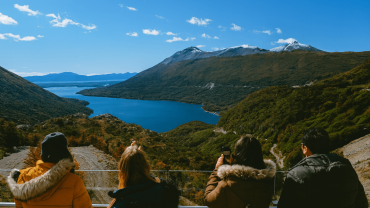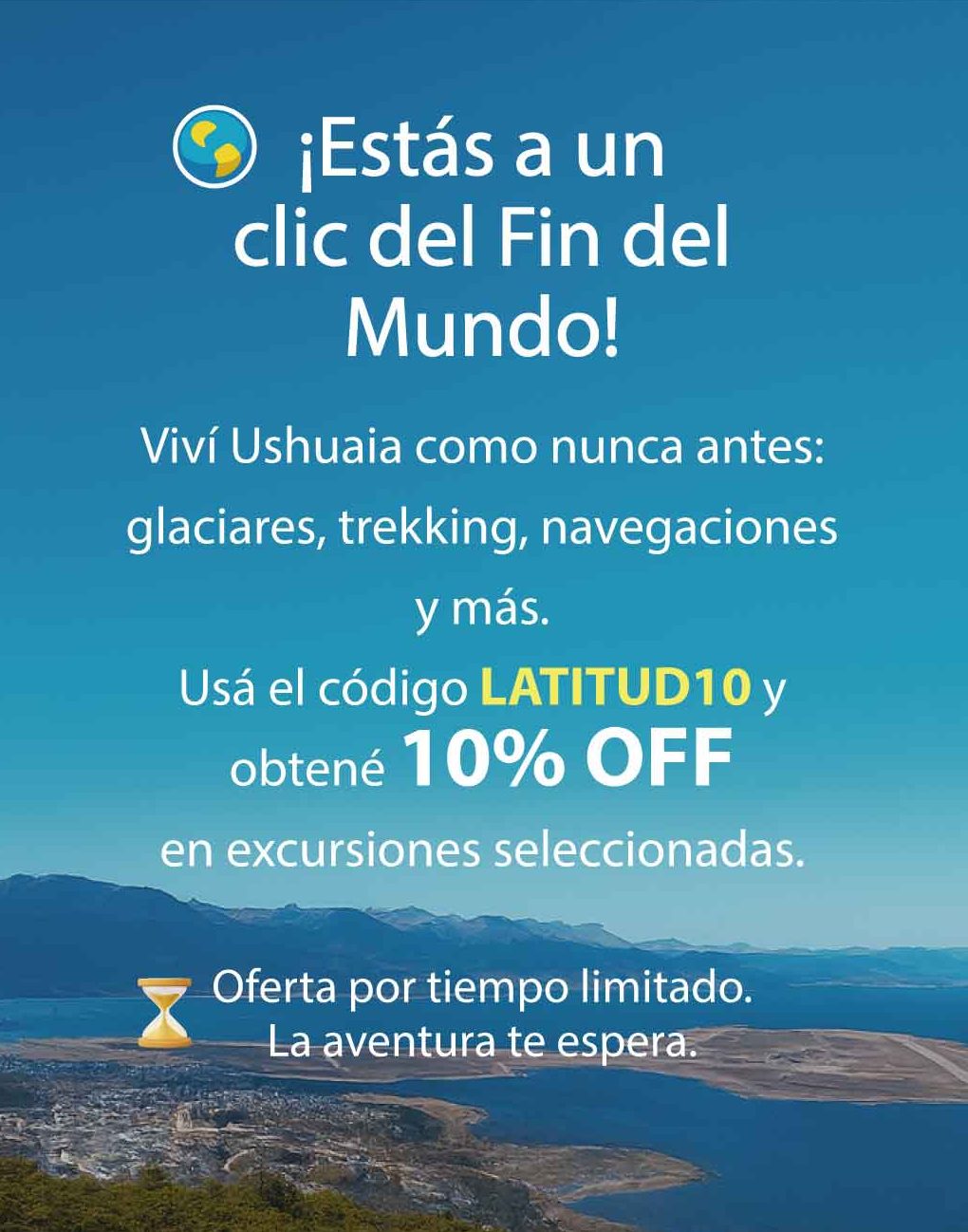Trail to the Beban Waterfall – Ushuaia, Tierra del Fuego

Beban Waterfall is one of Tierra del Fuego’s most impressive natural attractions, featuring a 12 km trail. Nestled at the foot of Cerro Falso Bonete within the Valle Tierra Mayor Natural and Scenic Reserve, this stunning waterfall lies just 17 km from Ushuaia.
During our hike to Beban Waterfall in Ushuaia, we discovered that this trail also serves as a junction for other fascinating routes, such as the Cerro Bonete refuge, Paso Beban, and Laguna Esmeralda. Its popularity is clear from the more than 5,000 views it has received on specialized platforms. When planning your trip, you’ve likely noted the must‑see stop of the End of the World Train but you may be wondering how to reach Beban Waterfall. In this article, we’ll share all the information you need to make your hike as safe and informed as possible. From planning tips to on‑trail recommendations, we’ll guide you through this adventure in one of the most spectacular landscapes at the end of the world.
Planning Before the Hike
Before setting out for Beban Waterfall, it’s essential to plan properly to ensure a safe and enjoyable experience. This trail is rated Level 2 (easy), with a total distance of 12 km (round trip) and an accumulated elevation gain of 204 m. The full hike takes approximately 4 hours, depending on your pace and the breaks you take to enjoy the scenery.
To reach the trailhead, take National Route 3 north from Ushuaia for about 17 km. When you arrive, you’ll find parking on a wide shoulder on the left side of the road. Right at the start of the trail, there’s an information sign that will orient you to the route.
Although the trail is open year‑round, conditions vary greatly with the seasons. In spring and summer you’ll enjoy milder weather and a generally dry path. However, in autumn and winter you must take extra precautions due to reduced daylight hours, below‑freezing temperatures, and the possible presence of mud, ice, or snow underfoot. You really have to watch your step—slip, land on your backside, and you’ll be taking home a bruise as a souvenir! 🙂
Trekking apparel and footwear are the most important items for the hike. They’ll let you tread more securely and maintain your body temperature appropriately for each season. If you go in cold weather, you’ll need thermal layers, a waterproof outer shell, and boots with good traction. In warmer seasons, it’s still wise to bring an extra layer, since Tierra del Fuego’s weather can change rapidly.
Recommended—and you might even say mandatory—to bring:
- Enough water and high‑energy food/snacks.
- Sunscreen and a hat (even on cloudy days).
- Map or app with the downloaded route.
- Basic first-aid kit.
Since it’s a natural environment, we must respect nature and carry all our waste back with us, as there are no trash bins. Bring a small or medium bag, and you’ll be all set to dispose of food wrappers and other rubbish.
Exploring the Beban Waterfall Trail

The route to Beban Waterfall begins on an old woodcutter’s trail used in the 1940s for timber extraction. After the first 800 meters of the hike, you come to the Esmeralda River, which you cross via a footbridge. Nearby, there’s a rest area with tables and chairs—perfect for taking a break.
Along the way, the trail winds through a variety of environments, including lenga forests that bear signs of historical intervention, expansive peat bogs, and transition zones. You can also spot fascinating natural features such as active beaver lodges, which reveal the impact these animals have on the ecosystem.
At kilometer 4 you reach a crucial junction where the path splits in three directions. You must watch for the signage: to the left you head toward Beban Waterfall, straight ahead leads to the Cerro Bonete refuge; and to the right you’ll connect with the Hacheros Trail, which later intersects the route to Laguna Esmeralda.
As we continue our way toward the waterfall, the trail gradually climbs until it brings us into a high‑mountain environment. Here, the dense forests give way to more open spaces where we can admire the high‑altitude peat bogs with their unique shapes and colors.
Finally, we reach our destination. We’re greeted by the refreshing… Beban Waterfall. From this panoramic vantage point, you can take in breathtaking views of the Valle Carbajal, the majestic Monte Olivia, and the surrounding peaks. On the opposite side you’ll spot the famous Paso Beban as well as the hanging Beban Glacier and other natural attractions. Dare to dip your hands into that icy water? Tell us about your experience!
The return to the trailhead is simply a matter of retracing your steps. If you come upon the spot where the path forks into three, that’s a sure sign you’re on the right track. By veering off about 1 km across the peat bog, you can reach the Cerro Bonete refuge and follow its trail back as an alternative.
Recommendations for Enjoying to the Fullest
To make the most of our visit to Beban Waterfall, it’s essential to have the right gear. Dressing in layers is ideal for adapting to Tierra del Fuego’s changing weather. A waterproof jacket paired with a thermal or fleece pullover will protect you effectively. Footwear should be purpose‑built for trekking—waterproof, with a sole that ensures good traction on the trail. Trekking poles are optional, but they can be very helpful for maintaining your balance, especially on slippery sections or when crossing footbridges.
Conclusion
Beban Waterfall leaves an indelible impression on visitors as one of those corners of Tierra del Fuego that makes you long to return. Every step along that moderate trail—initially promising nothing more than a simple hike—ultimately delivers an unforgettable experience.
The light filtering through the lenga trees casts shifting shadows over the peat bogs, the winding curves of the path, and the magnificent waterfall that suddenly appears, framed by the Valle Carbajal and the towering Monte Olivia—ensuring this breathtaking landscape is forever etched in your memory. Even the wind seems to hush itself to hear the roar of the water!
Those 12 kilometers (round trip) show exactly why this trek is so special. That said, “accessible” doesn’t mean “easy.” Hikers always thank us when we’ve recommended bringing waterproof boots after they cross the wettest sections!
If you’re someone who feels the cold, you’ll likely enjoy this landscape more in spring or summer. Even so, in autumn the fall colors are a spectacle in their own right. Just keep in mind: with fewer daylight hours, you’ll need to rise earlier.
They say Ushuaia is the end of the world, but for us that day was a beginning. The day when Patagonia whispered its secrets in our ear and left its mark on us. If you’re planning your trip, consider setting aside a full day for this hike. Wear good footwear, layer up warmly, and above all… bring an open heart so that this place can conquer you just as it conquered us.




Comment (0)